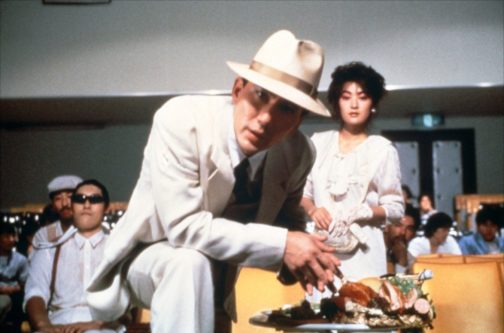
“So you’re at the movies too huh? Watcha eating?”
Here begins Jûzô Itami’s Tampopo of 1985. A mobster and his mistress, both glamorously suited head-to-toe in white, saunter to the front row of a movie theatre and set up their champagne feast. Our unnamed ‘Man in White Suit’ wastes no time addressing us, confidently leaning into the other side of the screen to see what we have brought to snack on during the feature, so long as it is nothing involving “crinkle wrappers”. After hysterically threatening to kill a man in the audience who dared to rustle about his chip packet, the movie theatre fades into darkness. The movie starts.
Tampopo is a visually delicious tale of food and love. The movie has always been a firm favourite of mine as a self-proclaimed ‘foodie’: each scene highlighting the etiquette of eating, the art of selecting the perfect ingredients and, above all, the momentous pursuit of the perfect bowl of ramen. Steam wafts from the surface of the hot broth so that you, behind the screen, can almost smell it. Chopsticks plunge into the soupy pool and retrieve long golden bands of noodles, followed by the menma and vegetables, and then succulent pieces of meat. Finally, the broth is sipped until the bowl is empty. I have never sat down to watch Tampopo on an empty stomach. It would be agony.
The central plotline of the movie – a parody of the American ‘Western’ genre – follows the eponymous Tampopo as she works to rejuvenate her rather mediocre ramen shop into one beyond compare. After a chance encounter with Gorō, a mysterious man on the road with an unparalleled knowledge of the dish, the pair toil to refine Tampopo’s ramen recipe, with a little help along the way. Punctured by a series of vignettes which explore other characters’ unique relationship with food, whether it be haughty French cuisine or hearty Italian pasta, Tampopo makes us fall in love with food again.
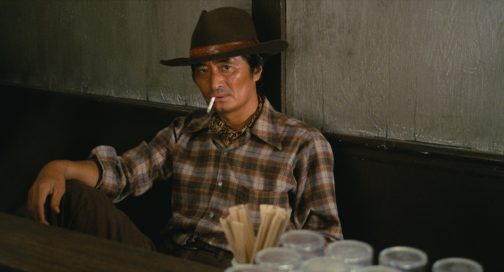
While food really is the main focus of the movie, Itami’s use of costume plays into his shrewd satire of the traditional Western genre, while contributing to the overall indulgent and sensual appeal of this food epic. Perhaps the most pertinent and ironic costume in the film is Gorō’s cowboy-esque look. His character is always dressed in a well-worn shirt – often with a neckerchief poking through in true Indiana Jones style – tucked into a pair of sturdy jeans. The Western look is completed with his trusty Stetson, which Gorō refuses to remove even in a scene where we see him in a bathtub. At times conniving, like the Western cowboys his character mocks, he encourages Tampopo to spy on other ramen shops to steal elements of their recipes. Gorō thus emerges as a comical play with the hero of the American Western. Like them, he is an adventurer. But he is an adventurer in search of good ramen, and the
only showdowns he engages in are with those who stand in his and Tampopo’s way.
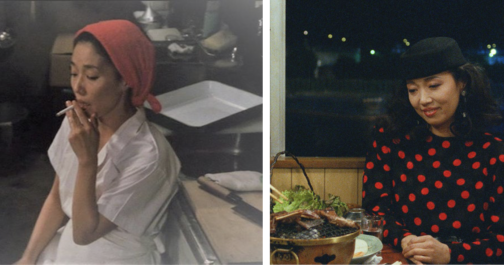
Throughout the movie, Tampopo herself undergoes a Cinderella type transformation both in her culinary skills and her fashion. When she begs Gorō to be his ramen-apprentice at the beginning of the feature, she wears a simple white uniform and a protective scarf to cover her hair. This white uniform appears rather fragile, wrapped in clouds of steam and cigarette smoke as Tampopo works relentlessly at her broth. When the ultimate recipe is near completion, Tampopo goes through a classic movie makeover, first showing off a new professional chef’s outfit and then sporting a stylish ensemble to accompany Gorō to dinner. Upon seeing her in this particularly fashionable outfit, Gorō moans that she now looks “hard to talk to”. Her red polka-dot dress, complemented by her matching red lipstick, gives Tampopo a renewed sense of conviction as she edges towards being crowned ramen chef par excellence.
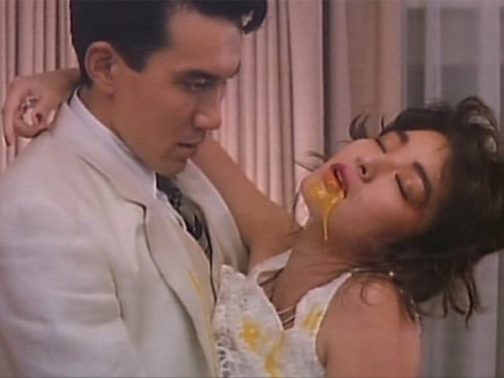
One of the most famed vignettes of Tampopo is the undeniably erotic ‘egg yolk’ scene between our mobster and his mistress. The couple pass between their open mouths a raw egg yolk, never allowing their lips to meet in a kiss, until it bursts in a moment of suggestive ecstasy. The golden liquid drips from the mistress’s mouth onto her dress, and transfers to the mobster’s lapel. Similar to those worn by the likes of Al Pacino in American gangster movies, his white suit was once a sign of his untouchable status. The indelible stain of the egg yolk on the once-pristine costume, however, speaks to the corruptive power of lust. And yet, this not merely a lust between man and woman, but between man, woman and food.
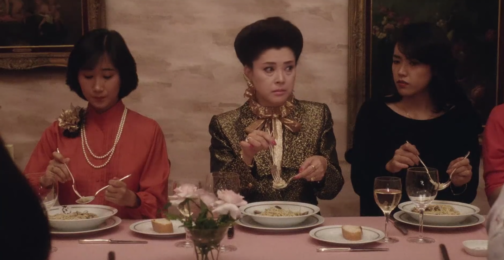
Raunchy interactions with eggs aside, Itami also uses the relationship between costume and food as a shrewd social commentary. One of the funniest vignettes (in my opinion) occurs when an old white gentleman sits down to eat dinner in an Italian restaurant in Japan. After ordering, he eavesdrops on a ladies’ society upstairs, who are being instructed by their leader on the ‘proper’ way to eat pasta like an Italian. This leader of the group, with her neatly coiffed hair and prim gold suit jacket, orders the women to never audibly slurp their spaghetti as this “is absolutely taboo abroad”. Much to her disdain, however, her commands are interrupted by the old man who is scoffing his spaghetti, and making a great noise while doing so. After watching him devour his meal, the ladies’ society and their leader succumb to mimicking his way of eating. Not a napkin in sight to protect their obviously pricey ensembles and accessories, regard for dress is thus cast aside – enjoying the meal is of the utmost importance.
Throughout Tampopo, Itami sets up a subtle yet provoking interplay between Western dress and etiquette, and Japanese tradition. His characters sport largely Americanised dress following the tropes of classic Hollywood genres which, according to Emiko Ohnuki-Tierney, signifies the Japanese sense of the self in relation to other nations. The conservatively dressed ladies’ society, the Western look of Gorō, and the Americanised glamour or Tampopo at the end of the movie might, at first glance, point towards an overwhelming European and American influence on Japanese culture. However, this imitation of Western eating habits and dress is exaggerated by Itami to the point of parody. What prevails is the art of ramen. Our movie closes with a visit to Tampopo’s new professional kitchen, where she prepares a final meal for her fellow ramen enthusiasts. They devour every last morsel, drinking the broth one after the other before placing their bowls down for the last time. We leave Tampopo behind, and accompany Gorō as he climbs aboard his truck once more. Our ramen cowboy slinks into the distance as the credits roll, ready for another adventure full of flavour.
You can watch Tampopo here: https://www.youtube.com/watch?v=csyMHLaWuSA
By Erin-Atlanta Argun
Sources:
Ohnuki-Tierney, Emiko. ‘The Ambivalent Self of the Contemporary Japanese’. Cultural Anthropology 5, no. 2 (May 1990). https://www.jstor.org/stable/656456.
Zimmerman, Steve. ‘Food in Films: A Star Is Born’ 9, no. 2 (Spring 2009). https://www.jstor.org/stable/10.1525/gfc.2009.9.2.25.
https://www.eater.com/2016/11/4/13513292/tampopo-movie-ramen-review
http://www.thecinessential.com/tampopo-lessons-for-an-endangered-species



